Dennis Lillee will be turning in his old age home if he’s been reading the recent comments by Jimmy Anderson and Glenn McGrath complementing each other in the media.
The former fiery paceman held the record for most Test wickets back in the 1980s (355 wickets, ave 23.92) and was a notably belligerent Aussie fast bowler who wasn’t afraid of swapping choice words or hitting batsmen about their bodies.
He would not like hearing the talk being bandied around in the media now that Anderson has overtaken McGrath as the paceman with the most Test wickets, 564.
‘You’re better than me.’ – Anderson.
‘No, you’re better.’ – McGrath.
‘You and Dale Steyn are BOTH better than me.’ – Anderson.
‘Come on, mate, you should keep going and get to 600 Test wickets.’ – McGrath.
There’s a whole lot of love going around that would surely baffle the hairy-chested Lillee, for whom fast bowling was all about aggression and domination. Lillee would, nonetheless, be proud of fellow Australian McGrath who, statistically, walks all over Anderson.
McGrath took his wickets in fewer Tests (124 vs 143), his average (21.64) is far better than Anderson (26.84), as is his strike-rate (51.90 vs 55.80). He also has a better nickname – Pigeon.
In Tests played with home ground advantage, Anderson has taken an average of 4,4 wickets per match – marginally above McGrath (4,3) – but away from home the Aussie took an average of 4,7 wickets per Test, while the Englishman has managed just 3,2. Point to McGrath.
When your side wins the toss and bowls first, you imagine things are in the bowler’s favour – Anderson averages 4,8 wickets per Test, McGrath 4,9 in such conditions. Even stevens.
Lose the toss and the opposition choose to bat first, presumably as the wicket is better for batting? Anderson takes 3,8 wickets per Test, McGrath 4,1. Another notch on McGrath’s belt.
Based on the record books there’s really no contest – it must be McGrath. He did have the benefit of playing in a very strong, winning side, and with Shane Warne sharing the bowling it put the batsmen under additional stress, which would surely have helped McGrath take more wickets. Regardless of that, though, he still had to bowl incredibly well to achieve his record wickets tally.
While England is a strong Test nation, Anderson has had the additional challenge of getting his wickets for a weaker side than the Australian side that supported McGrath (just think about dropped catches in the series against India alone, and then think about the Australian slip cordon). It’s impossible to quantify the difference this makes to their records, but it’s something that does need to count in his favour when comparing the two.
Perhaps, though, it boils down to who you would rather face out in the middle? With his additional height and uncompromising attitude, McGrath must have been a tricky customer to face, although he was more of a bowler that batsmen looked to endure and see off, which might account for his lower economy rate per over (2.49) compared to Anderson (2.88).
McGrath’s economy rate is actually one of the lowest in Test history, but that doesn’t impress me in judging the best pace bowler. Being difficult to score off is less important than the ability to get batsmen out.
Anderson is a wily bowler who does a lot more with the ball and seems to ask more of the batsmen, test them more, get them playing – hence the higher economy rate compared to McGrath. Anderson was absolutely superb in the 4-1 series win over India, taking the most wickets in the series (24) and doing a lot with the ball. Mind you, the Indian batsmen didn’t exactly cover themselves in glory with the way they applied themselves at the crease, so you can’t judge him as The Greatest based on that series.
For my money, McGrath walks the contest between the two men… but hang on a minute.
Anderson mentioned that Steyn was better than him, so let’s throw the Phalaborwa Express into the mix. Steyn might be 142 Test wickets behind McGrath, but he has played 36 fewer Test matches than McGrath – and 55 Tests fewer than Anderson!
England and Australia generally play a lot more Tests every year than South Africa, which also gives their bowlers more opportunities to take wickets and to find form, especially as both nations often play five-match Test series. This helps the bowler to find a good rhythm and work batsmen out during a longer series.
Let’s dive into the record books again. McGrath took his wickets at a cost of 21.64, while Steyn is one run more expensive (22.64), but you really shouldn’t judge the best pace bowler on his economy rate. What about strike rate? McGrath took a wicket every 51.9 balls… and… Steyn’s strike rate… is a wicket every 42.0 balls. That is simply devastating. That is the sign of greatness. Full bloody stop.
The best pace bowler is a strike bowler who takes wickets quickly. Thanks for coming.
Based on Test records AND how they perform in big matches against the best players, if I was selecting a team to try and BEAT the best World XI in a Test match, Dale Steyn would be the name I put down first to take the new ball. No question. No second guessing.
Who then to open with him? Also pretty easy, for my money. McGrath? Anderson?
Admire them both greatly, but I’d look lower down the list of most Test wickets taken. While I’ve crowned Steyn as king of the pacemen, I’d look to the crown prince, Kagiso Rabada, to take the new ball with Steyn. Rabada is more menacing than Anderson is and far more attacking and dangerous than McGrath was.
This young demon bowler with the cherub’s smile also has the best strike rate ever in Test history (if you ignore two chaps from the 1800s and a Kiwi who had a very brief Test career). Rabada also has an incredibly analytical brain that Mike Brearley would no doubt love to engage with for a couple of hours, if not longer.
For the record, the fast bowlers I would most hate to face would be Malcolm Marshall, Curtly Ambrose and Sylvester Clarke. Imagine being an opener if you had to see off 15 to 20 overs of that trio bowling? It’s almost unimaginable.
Why does none of them make my list ahead of Steyn or Rabada? Simple – Marshall’s strike rate was 46.7, Ambrose 54.5, Clarke 58.9, so Steyn and Rabada are better strike bowlers than those three. Clarke had a very limited career of course, although during the Rebel Tours to South Africa he did strike a lot of batsmen, as well as fear into an entire nation.
Those three were absolutely TERRIFYING during the 1980s and early 1990s… but aside from their lower strike rate, they also bowled at a time when batsmen had less physical protection and the game was more evenly poised between bat and ball. That helped to make them more menacing as bowlers. Today, however, so much more is in the batsman’s favour (think about protective equipment as well as bigger bats and higher batting averages), which is why I believe the best strike bowlers of today have to be viewed as the best pace bowlers in history.
It’s for that reason that my choice of opening bowlers to attack a World XI team would be Steyn and Rabada. If Steyn can stay fit for the next two years, South Africa will definitely take back the crown of number one Test nation – guaranteed – and especially because the Proteas’ first change bowler will be… Lungi Ngidi!
Crikey! These are golden times for Proteas fans.
The Proteas have had some ups and downs of late, but they’re on course for a record-breaking few years because, as the records always show… bowlers win matches.
Photo: Getty Images







